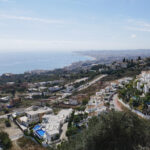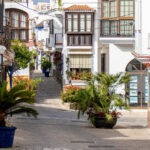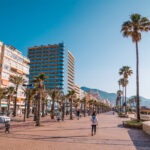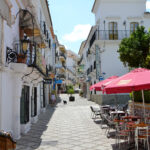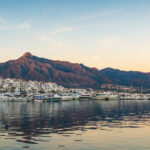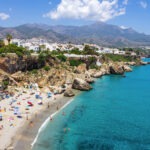
Costa del Sol – A world famous Andalusian coastline
Costa del Sol is usually the part of Andalusia’s coastal strip that stretches from Nerja in the east to Manilva in the west. This region has always been an important connecting link.
Phoenicians and Greeks once established a fishing and trading center that was later strengthened by Romans and Byzantines. Berbers, Italians and Jews settled on the coast, but the Moorish pirates made the coast dangerous.
At the end of the 19th century, the region regained its cosmopolitan character as the English, Germans and French contributed to trade in wine, raisins and ore. Today, the tourism industry is the major source of income for the local population. During the summer months the tourists invade the coast and during the winter months the population is increased by tens of thousands of property owners from different parts of the world, where the largest group consists of Englishmen. It is estimated that around 30,000 Swedes live more or less permanently in the area during the winter. The influx of all winter-weary golfers has naturally contributed to this development with the fantastic selection of over 50 golf courses.
If you settle on the Costa del Sol, you will be joined by the most famous Swedish brand in the world, IKEA, which came to the area ten years ago. On Tuesday, October 30, 2007, the department store opened its doors at the Plaza Mayor just outside Málaga with a strategic location right next to the exit to the airport. The Ikea department store in Málaga has had 28.7 million visitors since its opening. The department store’s restaurant, which has had 13.2 million visitors, has during these ten years served 14 tons of meatballs and 1.8 million Swedish hot dogs.
Andalucia – a little Arabic and a lot Spanish
The Costa del Sol is located in Andalusia, which is one of Spain’s 17 autonomous regions. Andalusia is the second largest region by area in all of Spain after Castile and León but has the largest population of all the autonomous regions. There are 8,440,300 people living in Andalusia and the region covers 17.2 percent of Spain’s surface. There are eight provinces in the region: Almería, Cádiz, Córdoba, Granada, Huelva, Jaén, Málaga and Seville, which is also the regional capital.

The name Andalusia – where does it come from? One of several theories is that it derives from the Arabic name Al Andalus, which refers to the parts of the Iberian Peninsula that were once under Muslim rule. Another theory is that the name originates from the Vandals, who ruled over large parts of southern Spain during the Migration Period and who gave the area the name Vandalusia. Somewhere later along the way through history, the V disappeared and we got our current Andalusia.
If the above explanation about Andalusia’s name is not correct, I would like to give another variant: Saint Lucia, from the 2nd century and Syracuse, wandered the earth looking for paradise. When she entered and saw the valley of the Guadalquivir on the Costa del Sol, she felt it was so beautiful that she thought she heard the Lord’s voice saying to her: “Anda Lucia” (Rise up, Lucia).
That’s how the Costa del Sol was discovered
It was at the beginning of the 1960s that the Swedes for the first time really discovered the Costa del Sol, or the Sun Coast as it is also popularly called. Already in the 1950s, bus trips from Scandinavia had been arranged, but only when the charter trips started coming to Torremolinos did the Swedes become interested in tourism on the Costa del Sol. Torremolinos quickly became a center for the Swedish tourists and remained so for many years. At that time, Benalmádena Costa, Mijas, Fuengirola, Marbella and Estepona were just smaller villages that mostly subsisted on fishing and agriculture.
The second major tourist destination on the coast was Marbella. When the Madrid architect José Banús built the Puerto Banús marina, a luxury project was developed, which immediately attracted tourists from all over Northern Europe. He built the casino, the bullring and many homes around Puerto Banús and so the coast had gained another place for tourism.
Step number three was the construction of golf courses on the Costa del Sol. As northern Europe has always had many golfers, a trip to southern Spain during the winter to play golf became a favorite vacation. In the years after the 1960s, the towns between Torremolinos and Marbella have developed into top class tourist towns. We are then talking about Benalmádena Costa, Mijas Costa and Fuengirola. Join us on a walk among the cities of the Costa del Sol to the most famous and popular resorts along the coast where the many northern Europeans have realized their “dream of Spain”.
Areas and cities on the Costa del Sol
-
Calahonda – the largest urbanization
27 June, 2023 -
Estepona – one of the most beautiful cities
27 June, 2023 -
Fuengirola – the favorite of many
27 June, 2023 -
La Cala de Mijas – the little gem
27 June, 2023 -
Málaga – the cultural capital of Andalusia
27 June, 2023 -
Marbella – most famous on the entire Costa del Sol
27 June, 2023 -
Mijas – the white city
27 June, 2023 -
Nerja – the secret gem of the sunny coast
26 June, 2023





